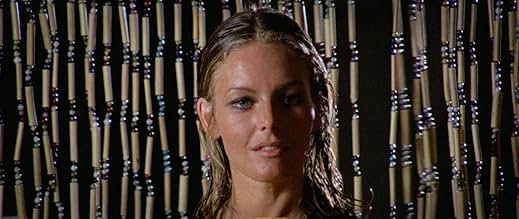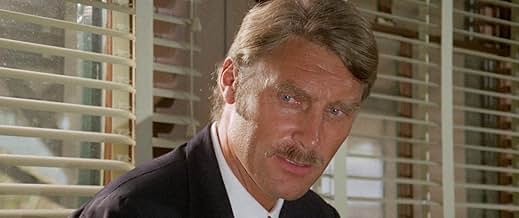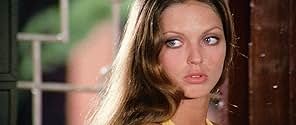Agrega una trama en tu idiomaWhile vacationing in Haiti, a married couple meet an old doctor friend who resides there. Dr. Williams has invented a new drug formula, and there are a few unscrupulous parties interested in... Leer todoWhile vacationing in Haiti, a married couple meet an old doctor friend who resides there. Dr. Williams has invented a new drug formula, and there are a few unscrupulous parties interested in acquiring it by any means necessary.While vacationing in Haiti, a married couple meet an old doctor friend who resides there. Dr. Williams has invented a new drug formula, and there are a few unscrupulous parties interested in acquiring it by any means necessary.
- Dirección
- Guionistas
- Elenco
Opiniones destacadas
I saw this for the first time recently. The poster looked cool n the review by Coventry regarding the gruesome kill made me see this boring giallo.
The only redeeming factor is the hot babe Anita Strindberg, one of the first giallo queens.
The babe had a unique chiseled face n sharp features n inspite of being very ectomorph (one can clearly see the breast bones rather than the cleavage), her face was really illecebrous.
The film lacks suspense n tension n the weird naked dance n the dream sequence is laughable. The kills r forgettable except for the fatso's face.
"Tropic of Cancer," co-directed by Giampaolo Lomi and Edoardo Mulargia, takes us on a slow-moving, otherworldly journey to Haiti. This Italian thriller, disguised as a giallo, weaves together elements of voodoo, betrayal, and murder.
While vacationing in Haiti, a married couple encounters an old doctor friend, Dr. Williams, who has invented a new drug formula. Unscrupulous parties are desperate to acquire it by any means necessary. The stakes rise as bodies pile up, and the film's unsettling atmosphere keeps viewers on edge.
Marcello Masciocci's excellent, colorful, widescreen photography captures the Haitian locations with an otherworldly feel. The film's framing adds to the eerie ambiance, making it stand out within the giallo genre.
Anthony Steffen delivers a solid performance as the conflicted doctor caught in a web of intrigue.
Anita Strindberg's unique beauty and icy cool screen presence enhance the film. Gabriele Tinti adds depth to his character, caught between desire and danger.
The film's blend of Haitian voodoo rituals and giallo elements creates an unusual and captivating experience. It's not based on Henry Miller's celebrated book of the same title, but it carves its own niche.
While "Tropic of Cancer" doesn't reach the heights of some giallo classics, its fresh ideas and unsettling atmosphere make it worth a watch. The film's visuals transport us to Haiti, where shadows hide secrets, and danger lurks in every corner. The haunting score adds to the film's unease, emphasizing the mysterious and otherworldly aspects.
🌟 Overall Verdict: "Tropic of Cancer" may not be a masterpiece, but its weirdness and unconventional blend make it a hidden gem for fans of offbeat thrillers.
While vacationing in Haiti, a married couple encounters an old doctor friend, Dr. Williams, who has invented a new drug formula. Unscrupulous parties are desperate to acquire it by any means necessary. The stakes rise as bodies pile up, and the film's unsettling atmosphere keeps viewers on edge.
Marcello Masciocci's excellent, colorful, widescreen photography captures the Haitian locations with an otherworldly feel. The film's framing adds to the eerie ambiance, making it stand out within the giallo genre.
Anthony Steffen delivers a solid performance as the conflicted doctor caught in a web of intrigue.
Anita Strindberg's unique beauty and icy cool screen presence enhance the film. Gabriele Tinti adds depth to his character, caught between desire and danger.
The film's blend of Haitian voodoo rituals and giallo elements creates an unusual and captivating experience. It's not based on Henry Miller's celebrated book of the same title, but it carves its own niche.
While "Tropic of Cancer" doesn't reach the heights of some giallo classics, its fresh ideas and unsettling atmosphere make it worth a watch. The film's visuals transport us to Haiti, where shadows hide secrets, and danger lurks in every corner. The haunting score adds to the film's unease, emphasizing the mysterious and otherworldly aspects.
🌟 Overall Verdict: "Tropic of Cancer" may not be a masterpiece, but its weirdness and unconventional blend make it a hidden gem for fans of offbeat thrillers.
A scientist invents a hallucinatory drug. Interest of different dubious people in this new drug lead to betrayal and murder.
This rather underrated and lesser known Italian thriller certainly has its flaws, nonetheless it belongs to the most innovative films of its genre that was booming in the early 1970s. Thanks to its fresh ideas packed in a traditional Giallo plot, it really stands out of the bulk, even though 1972 is probably the most Giallo-intense year ever. The most remarkable moments include feverish dream sequences that are erotic and nightmarish at the same time. The dreams are induced by similarly feverish Haitian voodoo rituals that feature mondo-style animal killing (there is also a non-ritualistic animal killing shown in a slaughterhouse - traces of social comment, obviously).
The erotic moments are more frequent and sensual than in the average Giallo, and they are very well done (as already mentioned, especially the dreams). The body count is also above average, and in the second half, the movie boosts some murders as creative as they are brutal. It also delivers elements of the spy film genre - drugs can always be sold for big money. And the climax is not necessarily Giallo-typical.
The leading cast consists of genre regulars: Anthony Steffen plays the inventive scientist and Gabriele Tinti the "hero"; Anita Strindberg is Grace, the woman with the unnerving dreams. On the other hand, the two directors are barely known and none of them made another Giallo (Edoardo Mulargia shot a few Westerns and some Women-in-Prison stuff, but nothing really significant).
AL TROPICO DEL CANCRO is not a masterpiece, but it's a sleeper of the genre with enough original and surprising elements to make it highly recommendable to the fans of the genre.
This rather underrated and lesser known Italian thriller certainly has its flaws, nonetheless it belongs to the most innovative films of its genre that was booming in the early 1970s. Thanks to its fresh ideas packed in a traditional Giallo plot, it really stands out of the bulk, even though 1972 is probably the most Giallo-intense year ever. The most remarkable moments include feverish dream sequences that are erotic and nightmarish at the same time. The dreams are induced by similarly feverish Haitian voodoo rituals that feature mondo-style animal killing (there is also a non-ritualistic animal killing shown in a slaughterhouse - traces of social comment, obviously).
The erotic moments are more frequent and sensual than in the average Giallo, and they are very well done (as already mentioned, especially the dreams). The body count is also above average, and in the second half, the movie boosts some murders as creative as they are brutal. It also delivers elements of the spy film genre - drugs can always be sold for big money. And the climax is not necessarily Giallo-typical.
The leading cast consists of genre regulars: Anthony Steffen plays the inventive scientist and Gabriele Tinti the "hero"; Anita Strindberg is Grace, the woman with the unnerving dreams. On the other hand, the two directors are barely known and none of them made another Giallo (Edoardo Mulargia shot a few Westerns and some Women-in-Prison stuff, but nothing really significant).
AL TROPICO DEL CANCRO is not a masterpiece, but it's a sleeper of the genre with enough original and surprising elements to make it highly recommendable to the fans of the genre.
The giallo universe takes the plane and lands in Haiti. A young faltering couple, Fred (Gabriele Tinti, La Morte risale a ieri sera) and Grace (Anita Strindberg, Una Lucertola con la pelle di donna), seeking for exoticism, goes on holidays in Haiti "expecting the heat of the tropics to rekindle their flame". But they come just in the middle of a perilous plot where is involved Fred's friend, Williams (Anthony Steffen, La Notte che Evelyn usci dalla tomba), an idealist doctor settled in the island, and inventor of a revolutionary aphrodisiac formula.
A bunch of unscrupulous businessmen lust for the new drug, from Peacock (Gordon Felio), an "ugly and fat man" found of young ephebes, and his greedy partner Garner (Stelio Candelli, La Morte scende leggera), to Prater and his violent henchman Murdock (Alfio Nicolosi), and all gather to the luxury hostel of Philippe (Umberto Raho, Sette scialli di seta gialla). And is Fred himself only in Haiti for vacation? Nevertheless, all those who track the marvelous potion become murdered through POV shot sequences by a mysterious killer gloved and shod in black, the corpses being found fully drained of their blood. Seeing she has been embarked in a very dangerous and deadlocked adventure, Grace seeks to flee away, but she might succumb to the call of the goddess Erzulie, mistress of "life and felicity", whom voodoo trances invite her to love.
The killer happening to be very ingenious, murders are always inventive and sophisticated. Unfortunately, the plot remains pretty confused, the motives of the murderer rather fuzzy, and the junction between the voodoo background and the pharmaceutic issue very wobbly, in spite of the fleeting appearance of the cursed Tetraodon fish of zombie poison. A very fine sequence full of reverie and eroticism with an Anita Strindberg under narcotics raises the level, but finally we stay much less far from Craven's Serpent and the Rainbow, not to mention Hitchcock's Capricorn other tropic. This movie shall however get attention from giallo addicts, and perhaps those interested in the Haiti under Duvalier, festal crowd sequences being put as "authentic in every details". (Viewed in the Italian 1h35 version.)
A bunch of unscrupulous businessmen lust for the new drug, from Peacock (Gordon Felio), an "ugly and fat man" found of young ephebes, and his greedy partner Garner (Stelio Candelli, La Morte scende leggera), to Prater and his violent henchman Murdock (Alfio Nicolosi), and all gather to the luxury hostel of Philippe (Umberto Raho, Sette scialli di seta gialla). And is Fred himself only in Haiti for vacation? Nevertheless, all those who track the marvelous potion become murdered through POV shot sequences by a mysterious killer gloved and shod in black, the corpses being found fully drained of their blood. Seeing she has been embarked in a very dangerous and deadlocked adventure, Grace seeks to flee away, but she might succumb to the call of the goddess Erzulie, mistress of "life and felicity", whom voodoo trances invite her to love.
The killer happening to be very ingenious, murders are always inventive and sophisticated. Unfortunately, the plot remains pretty confused, the motives of the murderer rather fuzzy, and the junction between the voodoo background and the pharmaceutic issue very wobbly, in spite of the fleeting appearance of the cursed Tetraodon fish of zombie poison. A very fine sequence full of reverie and eroticism with an Anita Strindberg under narcotics raises the level, but finally we stay much less far from Craven's Serpent and the Rainbow, not to mention Hitchcock's Capricorn other tropic. This movie shall however get attention from giallo addicts, and perhaps those interested in the Haiti under Duvalier, festal crowd sequences being put as "authentic in every details". (Viewed in the Italian 1h35 version.)
"Death in Haiti" is by no means a stellar or exceptional Giallo, but it's nevertheless a modest pioneer of some sort. Its release year was 1972, and that year is widely considered as the peak-performance for the Italian Giallo. In other words, up until 1972, and still even 2-3 years after, all Giallo writers and directors largely followed the proven success formula. It wasn't until after the mid-70s, when the popularly of these films started to decrease, that they began experimenting with filming locations outside of Italy or mixing typical Giallo plots with elements from other exploitation sub genres. Directors Giampaolo Lomi and Edoardo Mulgargia were among the first ones to take the authentically Italian concept abroad, evidently to Haiti in this case, and added the aspects of psychedelic drugs and traditional voodoo rituals. Who knows, maybe they just wanted to treat themselves to a tropic holiday destination, but at least they also grabbed the opportunity to make an enjoyable Giallo at the same time!
Co-writer Anthony Steffen, formerly a Spaghetti Western star, invented a nicely glamourous role for himself as the respected Doctor Williams; surgeon and businessman on the island of Haiti. He's always surrounded by rich, dubious and sleazy people because Williams also happens to have invented a powerful new drug. Grace, the beautiful blond wife of William's childhood buddy Fred can confirm the drug is quite efficient, because it causes her to hallucinate about dozens of naked black men and having sex with a voodoo priest! With drugs and money involved, it naturally doesn't take long before people are getting killed in various gruesome ways by an unseen assailant. The Haitian locations are beneficiary for the film, even though the obligatory tribal/voodoo dance rites are rather tedious and basically just form a cheap excuse to depict gratuitous nudity. Those gorgeous native Haitian girls obviously dance topless, or what else did you think? The genuine typical Giallo-whodunit plot is naturally the best thing about the film, and I must say there's a fair amount of mystery and suspense around the identity of the sadist killer. The extremely brutal murder taking place in an abattoir already makes "Death in Haiti" worth tracking down.
Co-writer Anthony Steffen, formerly a Spaghetti Western star, invented a nicely glamourous role for himself as the respected Doctor Williams; surgeon and businessman on the island of Haiti. He's always surrounded by rich, dubious and sleazy people because Williams also happens to have invented a powerful new drug. Grace, the beautiful blond wife of William's childhood buddy Fred can confirm the drug is quite efficient, because it causes her to hallucinate about dozens of naked black men and having sex with a voodoo priest! With drugs and money involved, it naturally doesn't take long before people are getting killed in various gruesome ways by an unseen assailant. The Haitian locations are beneficiary for the film, even though the obligatory tribal/voodoo dance rites are rather tedious and basically just form a cheap excuse to depict gratuitous nudity. Those gorgeous native Haitian girls obviously dance topless, or what else did you think? The genuine typical Giallo-whodunit plot is naturally the best thing about the film, and I must say there's a fair amount of mystery and suspense around the identity of the sadist killer. The extremely brutal murder taking place in an abattoir already makes "Death in Haiti" worth tracking down.
¿Sabías que…?
- TriviaNot based on the celebrated Henry Miller book of the same title.
- ErroresChasing Williams down an otherwise empty street, despite plenty of space to run around the only other person present, Garner appears to make a point of running straight for the guy to push him out of the way.
- Citas
Fred Wright: Having a slut for a wife can have its advantages.
- Créditos curiosos"The sequence of documentary nature were filmed on location, and are therefore authentic in every detail."
Selecciones populares
Inicia sesión para calificar y agrega a la lista de videos para obtener recomendaciones personalizadas
- How long is Tropic of Cancer?Con tecnología de Alexa
Detalles
Contribuir a esta página
Sugiere una edición o agrega el contenido que falta





















